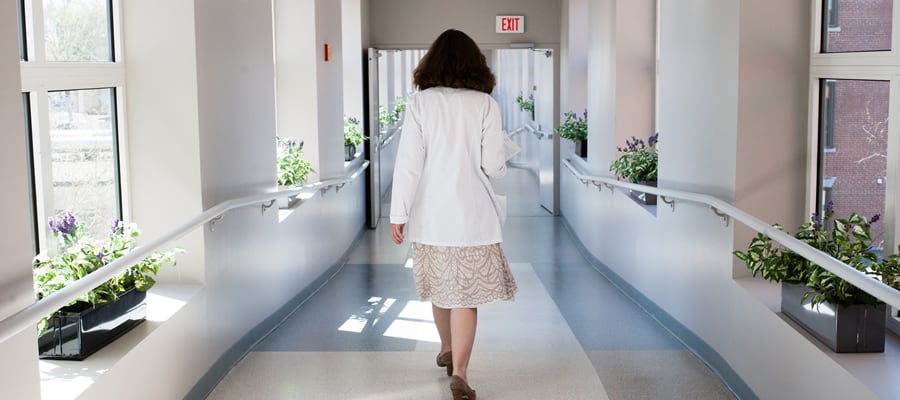
The following Operating and Clinical Indicators are provided with explanations as part of our report on the performance of Griffin Hospital:
Total Operating and Patient Revenue
The tables below show Griffin Hospital’s operating financial performance, including total operating gain (loss) and net patient revenue.
| Fiscal Year | Total Operating Gain (Loss) | Net Patient Revenue |
|---|---|---|
|
2011
|
($178,736)
|
$124,676,393
|
|
2010
|
($945,125)
|
120,621,808
|
|
2009
|
$1,230,684
|
$116,262,335
|
|
2008
|
($1,789,262)
|
$110,095,248
|
|
2007
|
$705,088
|
$110,095,248
|
|
2006
|
$411,215
|
$103,699,744
|
|
2005
|
$339,261
|
$91,910,383
|
|
2004
|
$1,248,105
|
$87,654,695
|
Griffin Hospital Total Discharges
The table below shows total patient discharges from Griffin Hospital over the past three years.
| Fiscal Year | Fiscal Year |
|---|---|
|
2011
|
7,494
|
|
2006
|
7,525
|
|
2009
|
7,533
|
|
2008
|
7,617
|
|
2010
|
7,719
|
|
2007
|
7,844
|
Total Outpatient Visits
The table below shows total Outpatient visits. Outpatient visits have shown a steady increase as Griffin Hospital introduced or enhanced outpatient services including the Comprehensive Wound Healing Center, Multiple Sclerosis Center, Special Procedures Unit, Pain Center, Rapid Diagnostic Breast Care Center, Digestive Disorders Center and the Sleep Wellness Center.
| Fiscal YearSorted By Fiscal Year In Descending Order | Outpatient Visits | Growth |
|---|---|---|
|
2011
|
191,512
|
2.7%
|
|
2010
|
186,418
|
4.0%
|
|
2009
|
179,202
|
4.0%
|
|
2008
|
172,227
|
2.9%
|
|
2007
|
167,304
|
3.6%
|
|
2006
|
159,487
|
(3.1%)
|
|
2005
|
164,640
|
2.6%
|
|
2004
|
160,427
|
4.2%
|
Griffin Hospital Average Length of Stay
To a consumer of healthcare a shorter length of stay means reduced exposure to risks associated with hospitalization including medication errors, falls, and hospital inquired infection. In addition, shorter length of stay usually means lower cost of care. Efficient medical care management with a continued focus on quality of care allows our physicians and care team to maintain this shorter length of stay.
The table below shows the Average Length of Stay at Griffin Hospital since 2004.
| Fiscal Year | Average LOS |
|---|---|
|
2009
|
4.46
|
|
2008
|
4.57
|
|
2007
|
4.34
|
|
2006
|
4.49
|
|
2005
|
4.36
|
|
2004
|
4.42
|
|
2010
|
4.33
|
|
2011
|
4.19
|
Emergency Department
In-depth, authoritative medical knowledge is only one way in which Griffin’s Emergency Department leads the way in providing critical care. Another important component is quick, efficient attention to emergencies, resulting in the shortest possible waiting time for patients and their families.
Griffin’s Emergency Department is staffed by board-certified emergency physicians, supported by physician assistants. Some of the physicians are double-certified in another specialty and are advanced cardiac care life support instructors. There are about 38,000 patient visits to Griffin’s Emergency Services Department annually.
There are two tracks in the department. One is for major emergencies, including complex medical cases. The other is for minor illnesses or injuries, for which our turn-around time goal (time from arrival to departure) is one hour.
Emergency Department Total Visits
Total Griffin Hospital Emergency Department Visits include visits to the Convenient Care/Urgent Care Center as well as to Emergency Services. The table below shows total Emergency Department visits for the by fiscal year.
| Fiscal Year | Visits |
|---|---|
|
2011
|
38,836
|
|
2010
|
39,702
|
|
2009
|
38,194
|
|
2008
|
38,895
|
|
2007
|
38,131
|
|
2006
|
36,164
|
|
2005
|
36,788
|
|
2004
|
35,833
|
Convenient Care Turn-Around Times
| Fiscal YearSorted By Fiscal Year In Descending Order | Average Minutes |
|---|---|
|
2013
|
67
|
|
2012
|
67
|
|
2011
|
60
|
|
2010
|
66
|
|
2009
|
66
|
|
2008
|
66
|
|
2007
|
63
|
|
2006
|
64
|
|
2005
|
61
|
|
2004
|
56
|